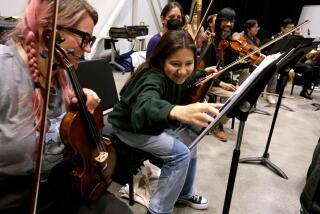Symbiosis: Haden With String Section
- Share via
You don’t expect the accompaniment to upstage the combo when a jazz quartet is augmented with strings. But that’s what happened Sunday at the Alex Theatre in Glendale when bassist Charlie Haden’s Quartet West, playing its 10th anniversary concert, was joined by a 22-piece string section.
Performing ballads and soft-bop pieces from its recent album with strings, “Now Is the Hour,” Haden’s Quartet gave its usual strong performance, full of emotional saxophone solos from Ernie Watts, detailed piano improvisations from Alan Broadbent, colorful percussive shading from drummer Larance Marable and Haden’s folksy, melodic soloing.
But the rich, often harmonically challenging string accompaniments arranged by Broadbent (who conducted the section from the piano) had the greatest impact, creating added emotional depth and imparting an even deeper sense of romance to the quartet’s already romantic mix of ballads, movie themes and soft-bop numbers.
At times, the strings served to bracket the quartet’s efforts, as in the case of Lennie Tristano’s “Requiem,” when their dramatic, minor-key introduction dissolved into the quartet’s upbeat bebop. Other times they served as a fifth instrument, as when Watts’ warm tenor play was stoked by violins and cellos on the Herb Ellis-Lou Carter-John Frigo ballad “Detour Ahead.” Frequently the section served both purposes, establishing a framework, then joining with the quartet as a harmonically astute member of the rhythm section.
There were a few instances when the strings and the quartet seemed to briefly lose sight of each other, as in the beginning of Haden’s “When Tomorrow Comes.” But mostly the two entities were alertly and sympathetically in sync while speaking with one voice. Old notions that jazz with string performances always finds the section playing second fiddle to the combo didn’t apply here. In short, Haden’s Quartet West performance with strings was a triumph.
Pianist Jacky Terrasson’s trio was put in the difficult position of closing the show, but its short, lively set, full of wide-ranging dynamic swings and playful approaches to standards, made for a nice contrast after the demands of Haden’s music. Terrasson twice used the opportunity to tuck one song inside another, as when “Autumn Leaves” was framed by Thelonious Monk’s “Blue Monk” in a way that complemented both. Terrasson’s musical identity, already strong, continues to evolve.
More to Read
The biggest entertainment stories
Get our big stories about Hollywood, film, television, music, arts, culture and more right in your inbox as soon as they publish.
You may occasionally receive promotional content from the Los Angeles Times.










